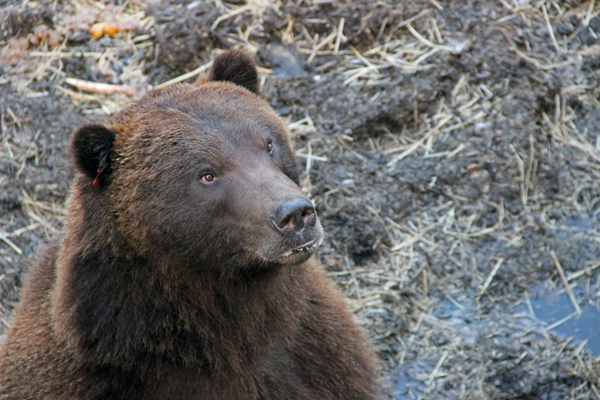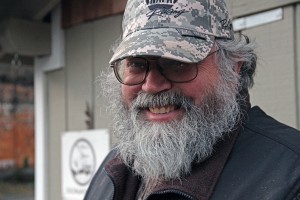
In 2003, a Sitka couple proposed creating a bear rescue center from the remains of the town’s decommissioned pulp mill – a plan that raised some local hackles.
Ten years later, the Fortress of the Bear is home to five brown bears and two new black bear cubs – and it has converted some skeptics, including a local biologist.
Les Kinnear may sound like he’s talking to a toddler
“Put your foot here. Huh? Baloo, foot! Foot! No? Ok,” he said.
But Baloo is an 800 pound brown bear
“You’re not listening, huh. Ok,” Kinnear laughs.

Kinnear runs Sitka’s Fortress of the Bear with his wife, Evy. He’s standing nose to snout with Baloo, a 4-year-old, 7-foot-tall brown bear, separated by only a couple inches and a metal grate door.
Kinnear was a hunting guide for years, hunting bears along with other big game. Now, he and his wife take care of seven bears in the remains of Sitka’s old pulp mill. All of the bears arrived as orphaned cubs that would otherwise have been euthanized.
“All you gotta do is have one of those little bears sit there and lick your hand, and you know the answer to that, that’s simple,” Kinnear said when asked why he started the Fortress.
The old pulp mill’s two giant clarifying tanks have been converted into bear pens, with high concrete walls.
Waldholz: It has kind of a post-apocalyptic feel in here.
Kinnear: Yes, it does.
It’s not just the bear pens. All the facility’s buildings were salvaged from the pulp mill or hauled over second-hand. Everything is rusty. There are piles of tires, sacks of supplies. A flock of assorted poultry roams around.
It’s a scrappy operation.
When the Fortress was first proposed in 2003, a lot of Sitkans weren’t thrilled.
“We have one of the highest known density of brown bears in the world – in the world!” Phil Mooney, the regional wildlife biologist for the Department of Fish and Game said. “So people were saying, why would you put a zoo here. “
He was skeptical at first. And he wasn’t the only one.
“Letters went to the governor; it was pretty divisive in the beginning,” Mooney said. “There was a big campaign to keep our bears wild, that people come here to see wild bears, not zoo bears.”
“There was a lot of really strong emotional response.”
But Mooney has since changed his mind. He remembers a delegation visiting from the Bronx Zoo. One of the women kept saying how impressed she was with the facility.
“And she turned to me and said, ‘you’re missing it because you’re thinking about this facility as a person. You have issues with the aesthetics of it. The bears don’t care about the aesthetics. They care that they have ¾ of an acre in there and they can dig, and do anything they want, like a real bear would,’” Mooney said.
But what really made Mooney a believer was when the Kinnears invited Sitka’s 3rd through 5th graders out to the Fortress. The Kinnears pitched two tents in the bear enclosure. Inside each was a sleeping bag with a hot dog in the bottom.
“And I’m standing in the back, just watching. And the bear ran straight over to the tents, slit the fabric, pull out the hotdogs and held them up…and the kids were like, I’m never taking food in my tent again,” Mooney said.
Mooney was impressed. He spends a lot of his time on bear education, trying to train people to avoid the kinds of interactions that lead to dead bears and orphaned cubs – trying to avoid, in fact, the kind of situation that brought these bears to the Fortress in the first place.
“This is Kilsnoo If you hold the mic up here you can probably hear them breathe,” Kinnear said.
Kilsnoo was the Fortress’s first bear. Mooney captured him in the summer of 2007, after the cub’s mother was shot trying to enter a lodge near Angoon.
“He was malnourished, dehydrated, terrified, traumatized, he had all the hair burned off his front paws clear to the shoulders, a belly full of tapeworms, a mouth full of broken teeth,” Kinnear said.
Kinnear says he understands why some folks object to the idea of the Fortress – in an ideal world brown bears shouldn’t live in old clarifying tanks.
His grand vision for the Fortress is much more ambitious. He wants to expand the habitats and eventually start rehabilitating bear cubs to return to the wild. This has been done in British Columbia and the Lower 48, but isn’t permitted in Alaska.
“We aren’t going to save a lot of bears,” Kinnear said. “We’ve only done a dozen in the last 10 years.”
“Some of the other places around the country where they process and release, they’re into the hundreds.”
Mooney says releasing bears isn’t likely any time soon, but he says the Fortress has a role even without that. He thinks these bears in captivity might turn out to be some of his best tools for keeping the rest of Sitka’s bears wild
Rachel Waldholz covers energy and the environment for Alaska's Energy Desk, a collaboration between Alaska Public Media, KTOO in Juneau and KUCB in Unalaska. Before coming to Anchorage, she spent two years reporting for Raven Radio in Sitka. Rachel studied documentary production at the UC Berkeley Graduate School of Journalism, and her short film, A Confused War won several awards. Her work has appeared on Morning Edition, All Things Considered, and Marketplace, among other outlets.
rwaldholz (at) alaskapublic (dot) org | 907.550.8432 | About Rachel




